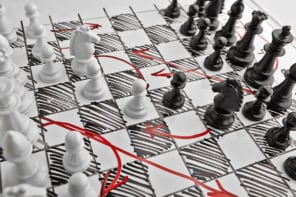Most storeowners wouldn't think to consult statistical mechanics in order to situate their premises -- but a French physicist has proven otherwise.
Techniques originally developed to study magnetic systems are being used in Lyons, France to help merchants find suitable locations for their shops.
Pablo Jensen had been modelling nanostructures for 15 years before he grew tired of it, deciding instead to adapt his skills to town planning. “That was four years ago,” he said, having recently assumed a position at the Institute of Complex Systems in Lyons, France. “I was having dinner with a friend, and we began to discuss the way that towns are laid out. We noticed that, for example, all the furniture sellers are in the same neighbourhood, whereas all the bakeries tend to be homogenously distributed. I wanted to try to quantify it.”
This might seem like an unlikely motivation for a research study, especially for a physicist, but it has in fact borne some rather interesting conclusions. In his paper (Phys Rev E 74 035101) Jensen has set about creating links between all retail locations, and has then attributed them ratios based on how much they attract or repel each other — in other words, whether one type of retailer is more or less likely to have another type existing within a close radius. Jensen has chosen this radius to be 100 metres, the average distance a person is willing to walk from store to store when shopping.
“Actually, the results were not affected greatly by changing the radius from 50 to 150 metres,” explained Jensen. “Of course, putting the radius equal to one metre messes up the results, and the model would probably not work in the US, where people are more likely to drive between locations.”
Once these data were calculated, he could then submit them to an algorithm based on the “Potts model” — an unlikely choice considering its normal application of describing interacting spins in a magnet. It just so happens, however, that a magnet provides an excellent analogy because aligned spins (those that attract) naturally cluster into homogenous domains to minimize free energy. The algorithm encourages the retail outlets into the same structure, but instead of minimizing the free energy, it maximizes the “satisfaction” so that each store is in a group where they are all attracted.
From an input of 8000 locations divided into 55 types of retail outlet, the algorithm judged five groups as necessary for optimum overall satisfaction. An initial glance down the list reveals few surprises: group four, for instance, includes “jewellery”, “textiles”, and “clothing” — stores that would predictably be in the same area. However, a closer look unearths some more unusual combinations, such as “make-up/beauty treatment” and “power laundries” together in group one.
“The self-negative interaction is easy to understand,” said Jensen. “Bakeries next to each other would be unfavourable. On the other hand, second hand shops tend to aggregate together.”
Having quantified the retail locations in this way, Jensen could then extract a “Q value” which rates the surrounding environment on its potential for a new store. The Q values vary between different store types — a promising site for an opticians, for example, may not be so promising for a hat shop.
Jensen is currently working with the Lyons Chamber of Commerce to help aspiring businesses to find favourable locations. But applying the model to other towns will not be as simple. “The model could be used in other homogeneous towns like Lyons, such as London or Brussels. But smaller, inhomogeneous towns with longer distances, different geography, et cetera, are much more difficult to analyse.”



